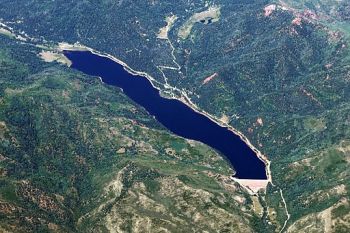Drinking Water Supply: Difference between revisions
Rmanwaring (talk | contribs) (Created page with "<!-- Delete any sections that are not necessary to your topic. Add pictures/sections as needed --> __NOTOC__ <!-- Add Category to drive breadcrumb menus --> Category: Environmental ---- {{Picture <!-- Add image file name (ex.image.jpg) --> |image= Lemon_Reservoir_Colorado.jpg <!--Add link if applicable --> |link= <!-- Add picture caption --> |caption= Lemon Reservoir in Colorado. }} <!-- Introductory paragraph or topic page summary --> "Regulation of re...") |
No edit summary |
||
| (3 intermediate revisions by 3 users not shown) | |||
| Line 11: | Line 11: | ||
<!-- Add picture caption --> | <!-- Add picture caption --> | ||
|caption= Lemon Reservoir in Colorado. | |caption= Lemon Reservoir in Colorado. | ||
(Image Source: [https://en.wikipedia.org/wiki/Lemon_Dam#/media/File:Lemon_Reservoir,_Colorado.jpg Wikipedia]) | |||
}} | }} | ||
<!-- Introductory paragraph or topic page summary --> | <!-- Introductory paragraph or topic page summary --> | ||
" | "The water requirement of a modern city is so great that a community system capable of supplying a sufficient quantity of potable water is a necessity. The first step in the design of a waterworks system is a determination of the quantity of water that will be required, with provision for the estimated requirements of the future. Next, a reliable source of water must be located and, finally, a distribution system must be provided. Water at the source may not be potable, so water-purification facilities are ordinarily included as an integral part of the system. Water use varies from city to city, depending on the population, climatic conditions, industrialization, and other factors. In a given city, use varies from season to season and from hour to hour. Planning of a water supply system requires that the probable water use and its variations be estimated as accurately as possible.<ref name="EM 1110-2-1420">[[Hydrologic Engineering Requirements for Reservoirs (EM 1110-2-1420) | Hydrologic Engineering Requirements for Reservoirs (EM 1110-2-1420), USACE, 1997]]</ref> | ||
== | "Regulation of [[reservoirs]] for municipal and industrial (M&I) water supply is performed in accordance with contractual arrangements. Storage rights of the user are defined in terms of acre-feet of stored water and/or the use of storage space between fixed limits of reservoir levels. The amount of storage space is adjusted to account for change in the total reservoir capacity that is caused by sediment deposits. The user has the right to withdraw water from the lake or to order releases to be made through the [[Outlet Works|outlet works]]. This is subject to Federal restrictions with regard to overall regulation of the project and to the extent of available storage space."<ref name="EM 1110-2-1420"/> | ||
{{Document Icon}} [[Hydrologic Engineering Requirements for Reservoirs (EM 1110-2-1420) | Hydrologic Engineering Requirements for Reservoirs (EM 1110-2-1420), USACE | |||
==Best Practices Resources== | |||
{{Document Icon}} [[Hydrologic Engineering Requirements for Reservoirs (EM 1110-2-1420) | Hydrologic Engineering Requirements for Reservoirs (EM 1110-2-1420), USACE]] | |||
<!-- In the location of an in text citation, simply enclose the citation as follows: <ref> citation </ref>. Citations will automatically populate. Learn more at https://www.mediawiki.org/wiki/Help:Cite.--> | <!-- In the location of an in text citation, simply enclose the citation as follows: <ref> citation </ref>. Citations will automatically populate. Learn more at https://www.mediawiki.org/wiki/Help:Cite.--> | ||
Latest revision as of 05:24, 21 July 2023

|
| Lemon Reservoir in Colorado.
(Image Source: Wikipedia) |
"The water requirement of a modern city is so great that a community system capable of supplying a sufficient quantity of potable water is a necessity. The first step in the design of a waterworks system is a determination of the quantity of water that will be required, with provision for the estimated requirements of the future. Next, a reliable source of water must be located and, finally, a distribution system must be provided. Water at the source may not be potable, so water-purification facilities are ordinarily included as an integral part of the system. Water use varies from city to city, depending on the population, climatic conditions, industrialization, and other factors. In a given city, use varies from season to season and from hour to hour. Planning of a water supply system requires that the probable water use and its variations be estimated as accurately as possible.[1]
"Regulation of reservoirs for municipal and industrial (M&I) water supply is performed in accordance with contractual arrangements. Storage rights of the user are defined in terms of acre-feet of stored water and/or the use of storage space between fixed limits of reservoir levels. The amount of storage space is adjusted to account for change in the total reservoir capacity that is caused by sediment deposits. The user has the right to withdraw water from the lake or to order releases to be made through the outlet works. This is subject to Federal restrictions with regard to overall regulation of the project and to the extent of available storage space."[1]
Best Practices Resources
![]() Hydrologic Engineering Requirements for Reservoirs (EM 1110-2-1420), USACE
Hydrologic Engineering Requirements for Reservoirs (EM 1110-2-1420), USACE
Citations:
Revision ID: 7367
Revision Date: 07/21/2023
